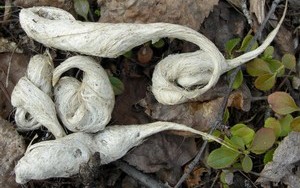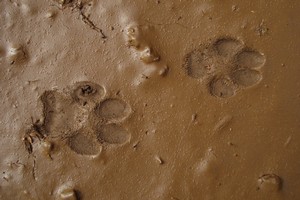Mammals
“After spending a summer engaged in a survey of Wells Gray’s wildlife, I left with a conviction that here is an outdoor laboratory par excellence. Within the park we now have populations of wolverine and fisher as dense as any on the North American continent. There is almost as great a variety and abundance of game and predatory animals as can be found in any other comparable area within the province.”— P. W. Martin, 1950
Wells Gray is home to 56 species of native mammals – a figure representing

Black Bear
None of Wells Gray’s mammals ranges throughout the park. Whereas the Mountain Goat clings to rocky mountainsides, enduring snowstorms in mid July, the Grizzly Bear roams the upper forests and meadows, digging for Glacier Lily bulbs and Columbian Groundsquirrels.
The greatest variety doubtless occurs in the vicinity of the Ray Farm, where a conservative estimate might run as high as 35 species. Keep in mind, however, that most mammals are shy and retiring; you’ll be lucky if you observe more than ten of Wells Grays residents during your stay.
Possibly the most common and widespread mammal is the Deer Mouse, found from valley bottom to the low alpine tundra. Occurring sparsely throughout much the same range are the Ermine and the Long-tailed Weasel – two of the Mouse’s fiercest predators.

Black Bear track
Some mammals are at or near the edge of their range in Wells Gray. The northernmost records of the Wandering Shrew and the California Bat, for example, have come from Hemp Creek. By contrast, the Pygmy Shrew and the Least Weasel are very close to their southern limits in the same area.
Wells Gray’s fauna has changed dramatically over the past 50 or 60 years, largely in response to fire. Some species have prospered, while others have gone into relative decline. Especially momentous was the great fire of 1926, which blackened 520 square km of bottomland and, in so doing, temporarily introduced an open “parkland” element to the Clearwater Valley.

Wolf scat
Hunting these tasty morsels were healthy populations of Wolves, Mountain Lion, Coyote, and, among the small-time predators, the Ermine and the Fisher. Clearly the period from the 1930s to the early 1950s was one of prosperity for such as these.
Possibly it was during this period, too, that White-tailed Deer and American Badger first entered the valley. Both these species are here very close to the northern edge of their range. In recent years the White-tail has come into its own in this area.

Coyote tracks
Even so, Wells Gray’s wildlife is clearly not all that it used to be. Nowadays, the Chipmunk is confined largely to the man-made burns, while the Beaver has in many areas run out of Aspen to gnaw. As for the Columbian Groundsquirrel, its lowland range is now mostly restricted to road edges and meadows. Meanwhile, the Badger may have disappeared altogether.
Following is a list of the park’s mammals.
| Mammals of Wells Gray Park | |||||||
VIEWING STATUS: (in appropriate habitat):
|
|||||||
| Common Name | Summer Status |
Winter Status |
Scientific Name | ||||
| Common Shrew | ! | — | Sorex cinereus | ||||
| Dusky Shrew | * | * | Sorex monticolus | ||||
| Pygmy Shrew | • | — | Sorex hoyi | ||||
| Vagrant Shrew | ! | — | Sorex vagrans | ||||
| Water Shrew | * | — | Sorex palustris | ||||
| Big Brown Bat | ** | — | Eptesicus fuscus | ||||
| Little Brown Bat | *** | — | Myotis lucifugus | ||||
| California Bat | ! | — | Myotis californicus | ||||
| Hoary Bat | ! | — | Lasiurus cinereus | ||||
| Long-eared Bat | ! | — | Myotis evotis | ||||
| Long-legged Bat | ! | — | Myotis volans | ||||
| Silver-haired Bat | * | — | Lasionycteris noctivagans | ||||
| Varying Hare | * | * | Lepus americanus | ||||
| Common Pika | ** | — | Ochotona princeps | ||||
| Beaver | * | — | Castor canadensis | ||||
| Yellow Pine Chipmunk | ** | — | Eutamias amoenus | ||||
| Columbian Ground Squirrel | *** | — | Spermophilus columbianus | ||||
| Golden-mantled Gr. Squirrel | • | — | Spermophilus lateralis | ||||
| Northern Bog Lemming | • | — | Synaptomys borealis | ||||
| Hoary Marmot | ** | — | Marmota caligata | ||||
| Deer Mouse | ** | * | Peromyscus maniculatus | ||||
| Western Jumping Mouse | * | — | Zapus princeps | ||||
| Muskrat | * | — | Ondatra zibethicus | ||||
| American Porcupine | * | * | Erethizon dorsatum | ||||
| Bushy-tailed Woodrat | • | • | Neotoma cinera | ||||
| Northern Flying Squirrel | • | • | Glaucomys sabrinus | ||||
| American Red Squirrel | *** | *** | Tamiasciurus hudsonicus | ||||
| Heather Vole | ! | — | Phenacomys intermedius | ||||
| Meadow Vole | • | • | Microtus pennsylvanicus | ||||
| Long-tailed Vole | ! | — | Microtus longicaudus | ||||
| Southern Red-backed Vole | * | * | Clethrionomys gapperi | ||||
| Water Vole | ! | — | Microtus richardsoni | ||||
| Woodchuck | * | — | Marmota monax | ||||
| Coyote | * | ** | Canis latrans | ||||
| Red Fox | • | • | Vulpes vulpes | ||||
| Gray Wolf | * | * | Canis lupis | ||||
| Black Bear | ** | — | Ursus americanus | ||||
| Grizzly Bear | • | — | Ursus arctos | ||||
| Badger | • | — | Taxidea taxus | ||||
| Ermine | • | • | Mustela erminea | ||||
| Fisher | • | • | Martes pennanti | ||||
| Marten | ** | ** | Martes americana | ||||
| Mink | * | * | Mustela vison | ||||
| River Otter | * | * | Lontra canadensis | ||||
| Striped Skunk | * | — | Mephitis mephitis | ||||
| Least Weasel | • | • | Mustela nivalis | ||||
| Long-tailed Weasel | ** | * | Mustela frenata | ||||
| Wolverine | • | • | Gulo gulo | ||||
| Bobcat | * | • | Lynx rufus | ||||
| Cougar | * | • | Felis concolor | ||||
| Lynx | • | • | Lynx canadensis | ||||
| Caribou | * | * | Rangifer tarandus | ||||
| Mule Deer | *** | ** | Odocoileus hemionus | ||||
| Moose | ** | *** | Alces alces | ||||
| White-tailed Deer | ** | * | Odocoileus virginianus | ||||
| Mountain Goat | * | — | Oreamnos americanus | ||||
Text extracted, with partial updates, from the 2nd edition of Nature Wells Gray: A Visitors’ Guide to the Park, by Trevor Goward & Cathie Hickson © 1995, for several years out of print, and now awaiting sponsorship toward a third, much improved edition.

 Nature Wells Gray
Nature Wells Gray 

